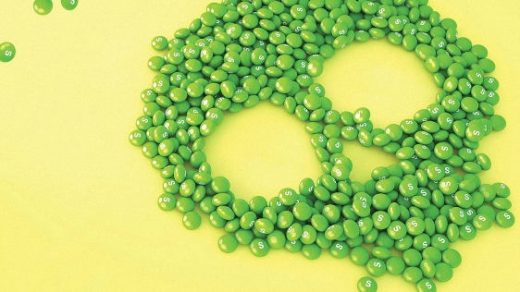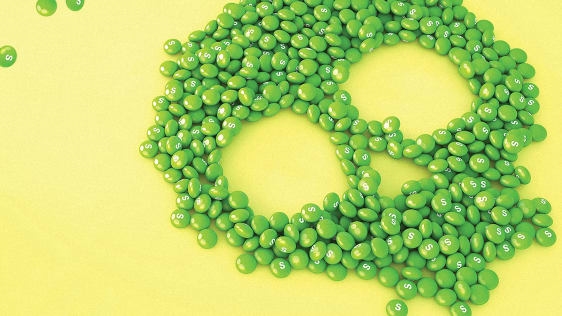Why Skittles has become the scariest brand this Halloween
Skittles has introduced us to a collection of colorful characters over the years, all suffering from a variety of rare afflictions and curious conditions.
There was Piñata guy at the office, Tim the Midas Touch guy at the bookstore, the Sheep boys, Beard guy in a job interview, and, of course, who could forget David Melwood, the man who was struck by a rainbow?
None of these folks, as far as we know, suffered from intestinal inflammation, cancer, or damage to their immune systems. After all, they were merely made-up characters as part of the Mars Wrigley brand’s efforts to cement its status as America’s favorite “non-chocolate chewy candy” amid its decades-long “Taste the Rainbow” campaign.
But the rainbow tastes a bit different heading into Halloween 2022. The Skittles brand’s trick-or-treating season feels kind of like its house is getting egged by one group while being toilet-papered by another.
In mid-July, a lawsuit alleged that titanium dioxide, an ingredient found in Skittles, causes cancer or immune-system damage. Mars had committed in 2016 to remove the toxic additive, but it’s remained in the rainbow candy since. While other candies, as well as over-the-counter medications such as Tums, include titanium dioxide, the suit directly targeted Mars and Skittles. A month later, a second suit made similar claims.
The lawsuits were receding from memory as the summer-themed candies and treats in the seasonal aisles at grocery and drug stores began to give way to fun-size candies for Halloween. That was when a now monthslong media blitz began around what the U.S. Drug Enforcement Administration called “rainbow fentanyl” in a warning on August 30.
Hmm, and what candy brand has worked masterfully to make itself synonymous with this particular multicolored meteorological phenomenon? Rainbow fentanyl quickly became this year’s razors-in-apples, causing Fox News and other like-minded outlets to call for the cancellation of Halloween. Then, right in the teeth of the spooky season, this week Los Angeles police seized thousands of suspected fentanyl pills hidden in candy boxes of SweeTarts, Whoppers, and, you guessed it, Skittles.
This is not the first time that the status of Skittles as a cultural signifier found itself being used amid an inherently political topic. Back in 2016, the brand dealt with another random and unfortunate association. A tweet from Donald Trump Jr. featured an image of a bowl of Skittles with a caption reading: “If I had a bowl of skittles and I told you just three would kill you. Would you take a handful? That’s our Syrian refugee problem.”
Mars responded immediately with a statement: “Skittles are candy. Refugees are people. We don’t feel it’s an appropriate analogy. We will respectfully refrain from further commentary as anything we say could be misinterpreted as marketing.” As a brand response to an unfortunate spoke in the news cycle, it was perfect. This is a brand and parent company that clapped back at Don Jr. within 24 hours.
But today, for an equally ridiculous association? Crickets. A U.S.-based spokesperson shared this statement with Fast Company: “Halloween activities have returned to pre-pandemic levels and all our products, including Skittles, play a pivotal role in seasonal rituals while driving substantial growth for our flagship brands. At Mars Wrigley, we have very stringent quality and safety measures in place so all candy lovers can feel confident enjoying our products. If consumers believe their retail package has been opened or tampered with, we of course ask them to refrain from consuming any tampered-with product. We always encourage our consumers to be observant and mindful with Halloween goodies to ensure this special time of year is a safe, great experience.”
Which of the brand’s turns in the headlines matters more? It’s not the one you may think. Although the fentanyl scare is a random and unfortunate association, the lack of response to the titanium dioxide accusations is the real horror show.
Six years ago this coming week, the Center for Food Safety reported that Skittles parent Mars had “clarified and reiterated its commitment to remove harmful and potentially poisonous nanoparticles of titanium dioxide from its food products, including many popular candies.” That renewed vow followed a February 2016 statement from the company that committed to removing artificial colors from its food products over the next five years. The company later said in an email to the Center that it was including titanium dioxide among the colorants that it would remove from human food products. Again, that was six years ago.
So far, the company hasn’t publicly commented on either titanium dioxide lawsuits filed. The question is, why not? Mars Wrigley should have an explanation as to why, six years after making a five-year commitment, the disputed ingredient is still a part of its rainbow-colored cash cow. (The judge in the first case is slated to rule on a likely motion to dismiss in February 2023.)
Despite being included in thousands of food products—from candy and powdered drink mix to cottage cheese and cake icing—titanium dioxide was linked in a 2017 study to those aforementioned health maladies. France called for a ban of titanium dioxide in 2020, but other countries, including Canada and the U.K., still allow it. That’s all to say that the plaintiff’s claims are not settled science worldwide.
But Mars’s silence actually makes the situation worse. It could have a perfectly good explanation, particularly for missing its self-imposed removal deadline, but no one’s heard it yet. The only public statement so far was from Justin Comes, VP of R&D at Mars Wrigley North America, who told The New York Times in July that the company’s use of titanium dioxide “is in full compliance with government regulations. While we do not comment on pending litigation, all Mars Wrigley ingredients are safe and manufactured in compliance with strict quality and safety requirements established by food safety regulators, including the FDA.” No word on not honoring its own commitment to remove it.
I asked Americus Reed II, a marketing professor at the University of Pennsylvania’s Wharton School, about how Skittles should be balancing both the rainbow fentanyl and titanium dioxide issues. Reed says that there is a basic brand crisis playbook made up of three main points. First, a company needs to validate the public’s concern.
“When something happens, it’s not apologizing—yet,” Reed says. “What the research finds is that consumers are often okay if you just say, ‘Hey, you know what, something has gone really wrong here, and we recognize you have been affected by it.’ So you’re validating concerns as a precursor to buy time to get more information.”
Next up is to show action. Basically, a company needs to come out and say it recognizes that some damage has been done and that it’s taking the situation seriously. And, crucially, it needs to present a plan to address the problem.
The third is to control the narrative. “Sometimes companies make a mistake by not saying anything, and that void gets filled by things that a) may not be true, and b) are completely out of your control,” Reed says.
Skittles and Mars have done none of this on either issue. Instead, we see the promos for All Hallows’ Eve as if none of this is happening.
What’s really surprising is that I’m old enough to remember seven months ago when Skittles boldly apologized for ditching its lime-flavored pellet, announcing its return by creating a 35-minute livestreamed press conference in which it individually apologized to all 130,880 people who complained about the flavor’s removal over the last nine years on social media.
What surprised me then was how a simple act of genuine corporate apology—done creatively as a piece of advertising itself—could be such a refreshing entry into the canon of brand mea culpas. What’s shocking now is how a brand that’s been able to ride pop culture so well so consistently, and for so long, didn’t just dust off this playbook of transparent sincerity and apply it to both of its current issues.
Obviously a loose link to fentanyl and pending lawsuits are a wee bit more severe than trading lime for green apple in a bag of fruit-flavored candies, but that doesn’t change the fact that we live in an always-on, 24-hour media environment in which brands are constantly talking to us. Most of the time it exists as ephemeral silliness and whatever the hell this is. But if you’re interested in building trust with your audience, it also requires a level of transparency that makes most corporations queasy.
Say that rainbow fentanyl is unfortunate, it obviously has nothing to do with Skittles, and Mars Wrigley makes a donation to addiction treatment services. Say titanium dioxide gives Skittles its candy-coated magical shine and is actually fine. Say you’re working toward that 2016 commitment but it’s taking longer than you expected. Say you’re making an anti-drug PSA with Giannis Antetokounmpo.
According to CandyStore.com, Skittles is the second-most-popular Halloween candy in the U.S., just behind Reese’s Peanut Butter Cups. That’s unlikely to change even with the last three months of bad news. But Skittles is a brand that has almost perfected its voice through a constant mix of silly creativity that’s cleverly delivered. It picked the worst possible time to be silent.
(31)



